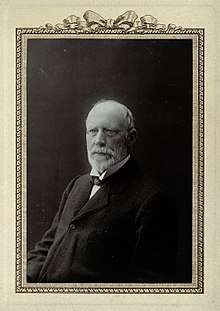Paul Mansion
Paul Mansion (3 June 1844 – 16 April 1919) was a Belgian mathematician, editor of the journal Mathesis.
Paul Mansion | |
|---|---|
 | |
| Born | 3 June 1844 |
| Died | 16 April 1919 (aged 74) |
| Alma mater | University of Ghent |
| Spouse(s) | Marie-Cécile Belpaire |
| Scientific career | |
| Fields | Mathematics |
| Institutions | University of Ghent |
| Thesis | Théorie de la multiplication et de la transformation des fonctions elliptiques (1867) |
| Doctoral advisor | Félix Dauge Mathias Schaar |
| Notable students | George Sarton |
Life and work
Mansion was the ninth of the ten brothers. His father died when he was only a baby and he was brought up by his mother and his older brothers. He studied at Huy school and high school.[1] In 1862 he entered in the École Normale des Sciences, attached to the University of Ghent, where he graduated in 1865. From this time till 1867 he taught mathematics in the artillery academy in Ghent, while he was working in his doctoral thesis. He was awarded PhD in 1867.[2]
In 1867, after the death of his professor Mathias Schaar, he was appointed to the chair of calculus at the university of Ghent.[3] He remained there until he was appointed to the chair of probability in 1892.[4] Also, from 1884, he taught the history of mathematics.
In 1874, with Eugene Catalan, he founded the journal Nouvelle Correspondence Mathèmatique, and in 1880, with Joseph Neuberg, he founded the journal Mathesis.[5]
The works of Mansion, deal mainly with non-Euclidean geometry,[6] history of mathematics,[7] and differential equations. He published 349 works in very different journals.[8]
References
- Demoulin 1929, p. 78.
- Demoulin 1929, p. 80.
- Demoulin 1929, p. 82.
- Demoulin 1929, p. 91.
- Demoulin 1929, pp. 106–107.
- Walter 1999, p. 105.
- Pyenson 1989, p. 360.
- Demoulin 1929, pp. 117–147.
Bibliography
- Demoulin, A. (1929). "La vie et l'oeuvre de Paul Mansion" (PDF). Annuaire (in French): 77–147.CS1 maint: ref=harv (link)
- Walter, Scott (1999). "The non-euclidean style of Minkowskian relativity". In Jeremy Gray (ed.). The Symbolic Universe: Geometry and Physics 1890-1930. Oxford University Press. pp. 91–127. ISBN 978-0-19-850088-9.CS1 maint: ref=harv (link)
- Pyenson, Lewis (1989). "What is the Good of History of Science?". History of Science. 27 (4): 353–389. doi:10.1177/007327538902700402. ISSN 0073-2753. PMID 11622212.CS1 maint: ref=harv (link)
External links
- O'Connor, John J.; Robertson, Edmund F., "Paul Mansion", MacTutor History of Mathematics archive, University of St Andrews.
- Pelseneer, J. (2008). "Mansion, Paul". Dictionary of Scientific Biography. Retrieved 12 November 2017.CS1 maint: ref=harv (link)
- "Mansion, Paul (1844-1919)". Bestor. 2017. Retrieved 15 November 2017.CS1 maint: ref=harv (link)
- Le Ferrand, Hervé (2019). "Paul Mansion (1844-1919) : plus de 400 publications mathématiques selon le Jahrbuch". arXiv:1903.06761 [math.HO]..